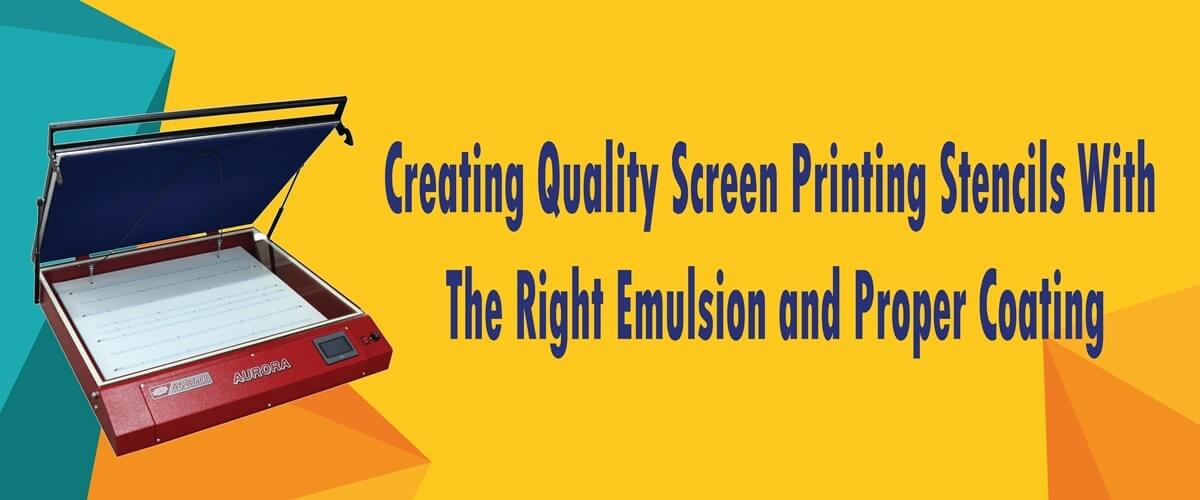No hay productos en el carrito.
es

Revolutionizing the screen printing industry through cutting-edge technology and quality service
Phone: +1 847-367-9760
Anatol Equipment Manufacturing Co.
1429 S Shields Dr
Waukegan, IL 60085

Revolutionizing the screen printing industry through cutting-edge technology and quality service
Anatol Equipment Manufacturing Co.
1429 S Shields Dr
Waukegan, IL 60085

The most obvious factor that goes into your stencil creation is your choice of emulsion. There’s a seemingly endless variety of emulsions available for screen printing, but three of the most common are:
While the right emulsion is key to a successful print run, you have to make sure you’re applying it correctly in order to get good results. One factor that’s easy to overlook is the thickness of your stencil. Your emulsion manufacturer will likely have charts available showing you how much emulsion you should use for different types of mesh. In general, the finer the mesh, the thinner the stencil.
You need to make sure you use the right amount of emulsion when creating your stencil. Too little emulsion can create stencils with rough, jagged edges, pinholes, or halftones with excess dot gain that causes dots to run together, causing a blurry print. If your layer of emulsion is too thick, it can make it difficult for ink to release from the stencil, lowering your print quality. Both too little and too much emulsion makes it difficult to judge the correct exposure time, meaning you could end up with underexposed or overexposed stencils. An underexposed stencil may degenerate over the course of a print run, or even be lost entirely during washout. Overexposed stencils may not wash out completely (or at all).
There’s no doubt that stencil thickness is an important factor in the quality of your prints, but many screen printing shops don’t have a consistent way of measuring it. A key term to know when it comes to stencil thickness is emulsion over mesh, or EOM. EOM measures how thick your emulsion is as a percentage of the mesh thickness. Your emulsion manufacturer will recommend appropriate EOM ratios. As a general guideline, 20% EOM is recommended for most garment printing. That means the thickness of your emulsion should be approximately 1/5 the thickness of your mesh. Jobs requiring finer details may need a lower EOM.
You can buy a stencil thickness gauge that will tell you the precise EOM of your stencil to make sure it matches the manufacturer’s recommendation. While these gauges may seem expensive, over time they will prove to be a valuable investment as you reduce wasted supplies, time and money due to misprints.
Another important factor in your stencil creation is the smoothness of your stencil surface, measured as Rz. This is a measurement of the average height of the peaks and valleys across the surface of your stencil. While your stencil may be uniformly thick across the entire screen, if the Rz is not smooth enough, you may still end up with print problems as the edges of the stencil don’t form a proper seal for the ink to pass through, lowering your print resolution. Rz meters can help you determine how smooth your stencil surface is, and they can be helpful tools in screen printing shops that are regularly called on to produce very finely detailed prints.
While simply measuring your stencil by sight or feel may be enough for jobs that require less precision, highly detailed screen prints require more finely tuned stencils. By paying close attention to your choice of emulsion, and the thickness and smoothness of the coating, you can capture very fine details with durable, high quality stencils.
For more information on creating screen printing stencils that perform, check out these blog posts:
Preparing Your Screens the Right Way: Screen Printing Emulsion Techniques and Timing
How to Print Film Positives for Sharp Screen Printing Stencils
Get Crisp Screen Printing Stencils with the Right Exposure Unit
Your message was successfully sent!